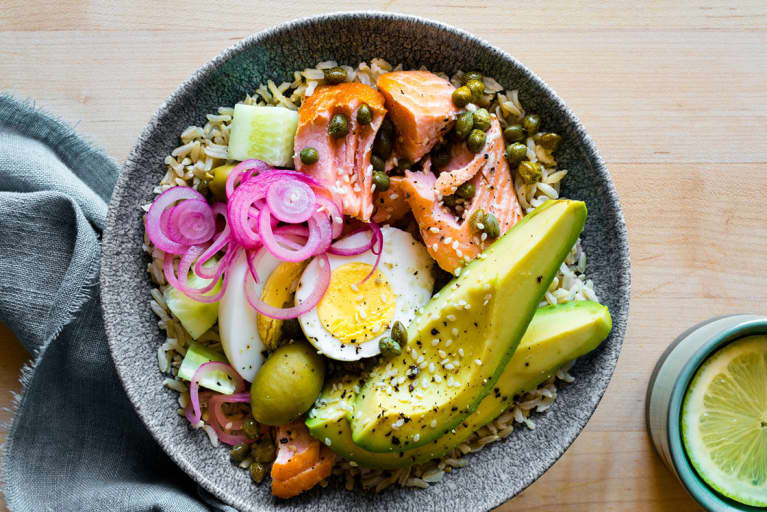How Do You Know When You Have Low Blood Sugar
Practice You Accept Good for you Blood Carbohydrate? Here'due south How To Tell + How To Maintain It Naturally

Terminal updated on August thirteen, 2021
Nosotros've all experienced the profound bear upon our claret sugar levels have on energy and mood, and it's no fun. Similar when you consume too many sweets. For a few minutes, yous are flight high, happy as tin can be. And so comes the as intense crash, leaving you exhausted, cranky, and craving another sweet treat.
But beyond being an free energy-draining badgerer, imbalanced blood sugar can seriously impair your ability to run across the demands of daily life, and—if chronically elevated—wreak havoc on your long-term wellness.
Here's how to tell if yous have a healthy blood sugar level and simple ways to go on information technology that way, naturally and effectively.
Signs your claret sugar is out of whack.
Even if you think you lot pb a relatively healthy lifestyle and have your blood carbohydrate level under control, not everyone's skillful at spotting the warning signs. When you don't manage your blood saccharide level accordingly, hyperglycemia (high blood sugar) and hypoglycemia (low blood sugar) tin occur as the level rises and falls drastically. This is a serious issue that requires medical attention and comes with a number of unpleasant side furnishings, including:
- Fatigue
- Carbohydrate and carb cravings
- Weight gain
- Headaches
- Trouble concentrating
- Mood swings or nervousness
- Dry skin
- Excessive thirst
- Frequent peeing
- Blurred vision
Suboptimal blood sugar remainder can lead to mutual complications, including fatigue, weight gain, and sugar cravings. The expert news: With the right lifestyle and dietary tweaks, maintaining salubrious blood sugar is easier than you think.
15 ways to assist maintain a healthy blood saccharide level naturally.
Consider implementing the following strategies to maintain a healthy blood carbohydrate level and keep it balanced:*
1. Follow a minimally processed diet.
Your first dietary step toward a more balanced blood sugar level: ditching (most of) the packaged foods and focusing on high-quality whole foods such as vegetables, fruits, whole grains, beans, nuts, seeds, and quality meats and fish. Many processed foods are high in sugar, refined grains and carbs, and bogus ingredients and flavorings while being low in blood-saccharide-stabilizing fiber and protein.
Of course, it'south also important to be realistic. You lot're probably not going to be able to nix packaged foods completely, and then just make a point to select those that are made from generally whole-nutrient ingredients, similar an energy bar that lists simply basics, seeds, and dried fruit on its label.
ii. Load up on fiber.
Your minimally processed diet should exist heavy in nonstarchy, cobweb-rich vegetables and fiber-rich fruit and whole grains. That'due south because cobweb slows down the digestion of carbohydrates and the absorption of saccharide, which means you experience a more gradual ascent in your blood sugar level after meals.
Practiced sources of fiber include leafy greens, Brussels sprouts, broccoli, artichokes, raspberries, pears, beans, lentils, peas, avocados, pumpkin seeds, and oatmeal.
3. Consume enough of high-quality poly peptide.
Like fiber, protein tempers insulin secretion, leading to a more than gradual rise in blood sugar after a repast. Information technology likewise fills yous upwardly better than any other nutrient. Eating a protein-rich breakfast is particularly of import considering it helps ready the tone for the rest of the day.
The corporeality of protein you demand in your diet depends on a number of factors, just the general protein recommendation for healthy adults is 0.viii to one.0 gram per kilogram of body weight (55 to 68 grams per mean solar day for someone who weighs 150 pounds).
Good animal sources include wild-caught fish, grass-fed beef, and pasture-raised chicken and eggs. If y'all're vegetarian or vegan, non to worry, we rounded up 54 sources of establish-based poly peptide.
iv. Consume healthy fats.
Similar fiber and protein, fat buffers blood sugar spikes. In fact, unsaturated fats have been specifically linked to improved insulin resistance.
Only be sure to avoid refined fats, including trans fats and processed vegetable oils, similar corn, soybean, and safflower oils, which tin can exist pro-inflammatory. Sources of quality fats to consider adding to your diet include nuts, olive oil, ghee, kokosnoot oil, avocado, and fatty fish similar salmon.
5. Switch upward your carbs.
Lowering your overall intake of carbohydrates can also be helpful for balanced blood saccharide, but you don't demand to cut them out completely (they're still a crucial source of fuel for your body). Whenever possible, simply bandy out refined carbohydrates like bread, white pasta, and candy for fiber-rich, whole-food sources such equally whole grains, sweet potatoes, and fruit, which contain a number of vitamins, minerals, and antioxidants essential for health.
six. Balance your meals.
Eating some protein, fiber, and healthy fat with each meal tin assistance stabilize blood sugar and manage your appetite. Each of these nutrients helps residue blood sugar on its own, simply they're fifty-fifty better together. We love a proficient kale salad topped with avocado and a protein of choice.
7. Supplement with a greens powder.
Greens powders are stale, powdered forms of various vegetables and fruits. Specialty greens blends volition sometimes include prebiotic fibers too. These antioxidant-laden superfood plants and tiresome carbs are blood sugar-friendly.*
If yous struggle to stick with salads or you're looking to up your veggies game, then greens powders can help you evangelize some greens goodness and aid maintain a healthy blood sugar level.* In fact, one report plant that calculation a vegetable powder to a loftier-saccharide diet helped buffer the short-term glucose and insulin response.*
8. Consume bigger meals earlier in the twenty-four hours.
A giant, late-night dinner is your blood saccharide's worst enemy. That's considering our bodies become more insulin resistant equally the day goes on—so a meal that you swallow in the evening will cause a greater spike in claret saccharide than a meal y'all eat in the forenoon.
Because of this, many diet experts advise front-loading your meals, or eating bigger meals earlier in the day and having a smaller dinner at to the lowest degree three hours before bed.
ix. Slumber more, stress less.
Both sleep impecuniousness and stress tin can cause elevated levels of the stress hormone cortisol, which raises blood saccharide. Aim for seven to nine hours of sleep per night, and adopt stress-busting habits such as exercise, meditation, or yoga.
One study establish that nursing students who did meditation and yoga experienced lower blood sugar spikes after meals.
10. Drink enough of water.
Drinking h2o helps your kidneys affluent out excess blood sugar through your urine. One study plant that people who drank more than water had a lower risk of developing hyperglycemia (high blood sugar).
Can't seem to potable enough? Or is water is only besides plain for your taste buds? Try this R.D.'s go-to hydration strategies.
11. Exercise regularly.
Your muscles demand blood glucose for fuel, which means that when you do that strength grooming routine, you're helping move claret carbohydrate from the bloodstream into the muscles where it's then burned up. Over time, this can help yous maintain a healthy blood saccharide level and increment insulin sensitivity (i.e., how well your cells are able to absorb glucose from the blood and utilise it for free energy).
Intense exercise tin can temporarily enhance blood sugar, so if you have poor blood sugar control, and so it makes sense to first moderate (retrieve walking, jogging, or yoga), and so work your way up.
12. Have a shot of apple tree cider vinegar.
Swigging apple cider vinegar might not sound highly-seasoned, but it could assistance go on your blood sugar in residual if taken before you swallow. Some inquiry has institute that consuming ACV reduced postal service-meal claret saccharide levels by nearly half in salubrious patients. The theory is that acetic acid, a component of the vinegar, slows down the conversion of carbohydrates into saccharide in the bloodstream. Pro tip: Mix a tablespoon or two into a glass of water—taking it straight will burn!
13. Sprinkle on some cinnamon.
Research on cinnamon's blood-carbohydrate-stabilizing powers is a petty mixed, and it may not be a wonder spice. But if you're calculation it to an already healthy nutrition, and so it can have a subtle benefit, especially if you add a lot of information technology into your diet (more than than just a teaspoon).* Some studies propose that cinnamon promotes healthy blood sugar by increasing insulin sensitivity, or making insulin more efficient at moving glucose into cells.* Try sprinkling information technology onto oatmeal or into depression-carbohydrate smoothies (simply be sure to opt for Ceylon cinnamon if you use it regularly). Bonus: It tastes delicious!
14. Eat magnesium-rich foods.
Magnesium seems to be of particular importance when it comes to maintaining a healthy claret sugar level and improving insulin sensitivity.* Making a indicate to consume plenty of magnesium-rich foods—leafy greenish veggies like spinach and Swiss chard, pumpkin seeds, almonds, black beans, nighttime chocolate, and avocado—is smart in full general because magnesium plays a function in more than 300 biochemical reactions in the trunk.
Nosh on some chromium-rich foods like broccoli, barley, and oats while y'all're at it. One study constitute that the combined furnishings of chromium and magnesium were more beneficial than either mineral alone. You can also attempt a magnesium supplement to support optimal levels.*
15. Pop a probiotic.
Probiotics are an obvious supplement for supporting digestive wellness, but they can besides play an important part in blood sugar maintenance.* 1 pocket-size written report found that people who were following the heart-healthy DASH diet and too consumed probiotics experienced a decrease in fasting blood carbohydrate and hemoglobin A1C levels (a mark for testing longer-term claret sugar levels).*
In add-on to popping a quality probiotic supplement, add salubrious, probiotic-rich foods to your nutrition such as kefir, obviously yogurt, sauerkraut, kimchi, or even a piffling low-sugar kombucha. To help probiotic bacteria to thrive, eat plenty of prebiotic foods such every bit fiber-rich leafy greens and vegetables.
The bottom line: Accept a whole-body approach to maintaining a good for you level of blood carbohydrate.
No single nutrient, supplement, or workout session is going to be the magic bullet. To maintain a good for you blood sugar level (and keep it balanced for practiced), offset eating a minimally processed diet that contains fiber, protein, salubrious fats, and high-quality carbohydrates; get regular exercise; make sure you're hydrated and well-rested; play around with meal composition; and experiment with research-backed superfoods and supplements.
Pop Stories
https://www.mindbodygreen.com/articles/how-to-lower-blood-saccharide
In order to save this article, you volition need to Log In or Sign Up!
Close
fredericksonsurries.blogspot.com
Source: https://www.mindbodygreen.com/articles/how-to-lower-blood-sugar

0 Response to "How Do You Know When You Have Low Blood Sugar"
Enregistrer un commentaire